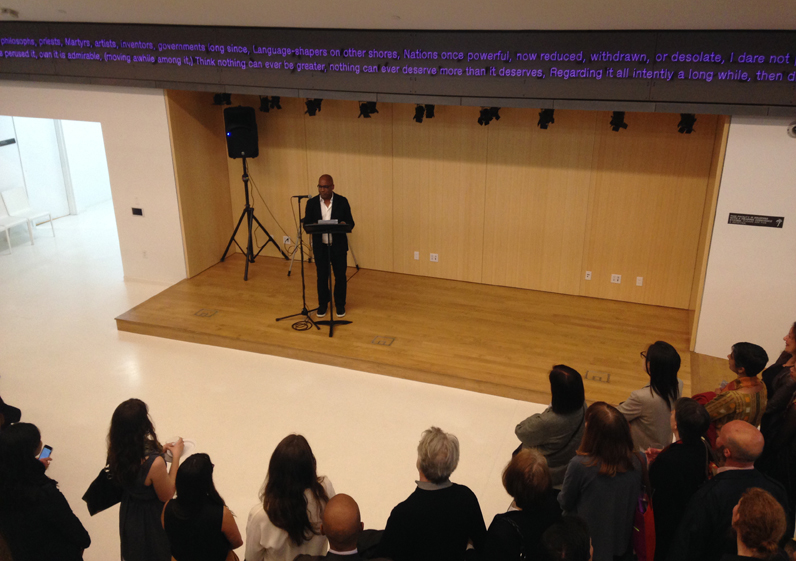
Glenn Ligon Unveils “Comrades and Lovers” at The New School
“You never know what the future will make of your work,” the artist Glenn Ligon told a crowd of New School students, faculty members and artists packed into the University Center’s first-floor Event Café on Thursday. “You don’t even know if your work will survive you.”
Walt Whitman couldn’t have imagined Leaves of Grass, his poetry collection published in 1855, becoming the iconic work that it is today. But it would’ve been even more difficult—impossible, even—for him to imagine his words spelled out in 400 feet of violet neon text, circling the perimeter of a space in a university building in the heart of New York City.
“This piece,” Ligon said, “is a testament to the fact that Whitman’s work survived.”
Ligon made his remarks at the celebration of the unveiling of his piece, “For Comrades and Lovers,” a monumental, site-specific installation for The New School. The commission, Ligon’s most ambitious neon work to date, presents the artist’s poignant investigation of the writings of Whitman, one of New York City’s most iconic and influential poets. “For Comrades and Lovers” is the latest addition to The New School’s art collection of site-specific works, which also includes pieces by José Clemente Orozco, Sol LeWitt, Dave Muller, Martin Puryear, Brian Tolle, Kara Walker and Alfredo Jaar.
During his talk, Ligon thanked a number of individuals behind the fabrication and installation of the piece, including Silvia Rocciolo and Eric Stark, curators of The New School Art Collection, and Matt Dilling and his team at Lite Brite Neon.
“Thanks for seeing this through with an incredible passion and good humor and constant attention to detail,” he said.
New School Provost Tim Marshall opened the reception by welcoming Ligon, “one of the most important American artists of our generation.”
“I want to thank Glenn for giving The New School ‘Comrades and Lovers,’ an extraordinary work of art that speaks to the ethos of the university,” Marshall said. “Walt Whitman, the great American poet, has had a profound impact on a generation of artists and writers. Glenn’s treatment of Leaves of Grass establishes its relevance in a day and age where tolerance, equality and social justice continue to be pressing issues.”
Ligon’s talk was followed by a moving performance of an original prose poem by Carl Hancock Rux, a performance artist, novelist and poet. Inspired by “Comrades and Lovers,” Rux elegantly wove Whitman’s text and his own thoughts on democracy and the power of language in a piece he entitled “Democratic Vistas of Space.”
“Light as words becomes our interaction with life, becomes thought, becomes wave and particle,” he said.
In his talk, Ligon articulated that idea in a different way. Reflecting on Whitman’s work, Ligon said that the poet had a talent for “expressing a thing without calling it by its name, of getting the essence of something in a way that went beyond language.”
“It seems like an impossible task, but I think Leaves of Grass is able to express impossible things like love, intimacy, the body and the soul,” Ligon said. “In a place like the Events Café, where people meet and greet and hang out, I think it’s fitting to have these words hovering in the air.”
For more information about The New School Art Collection, visit https://www.newschool.edu/provost/university-art-collection/.